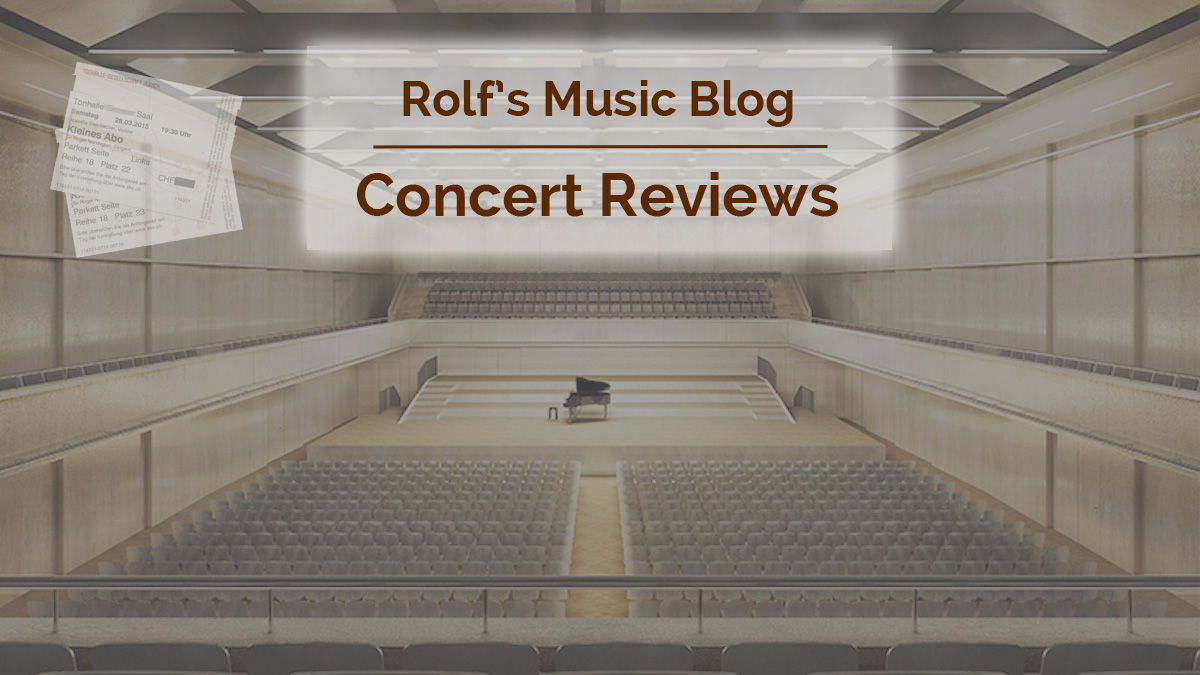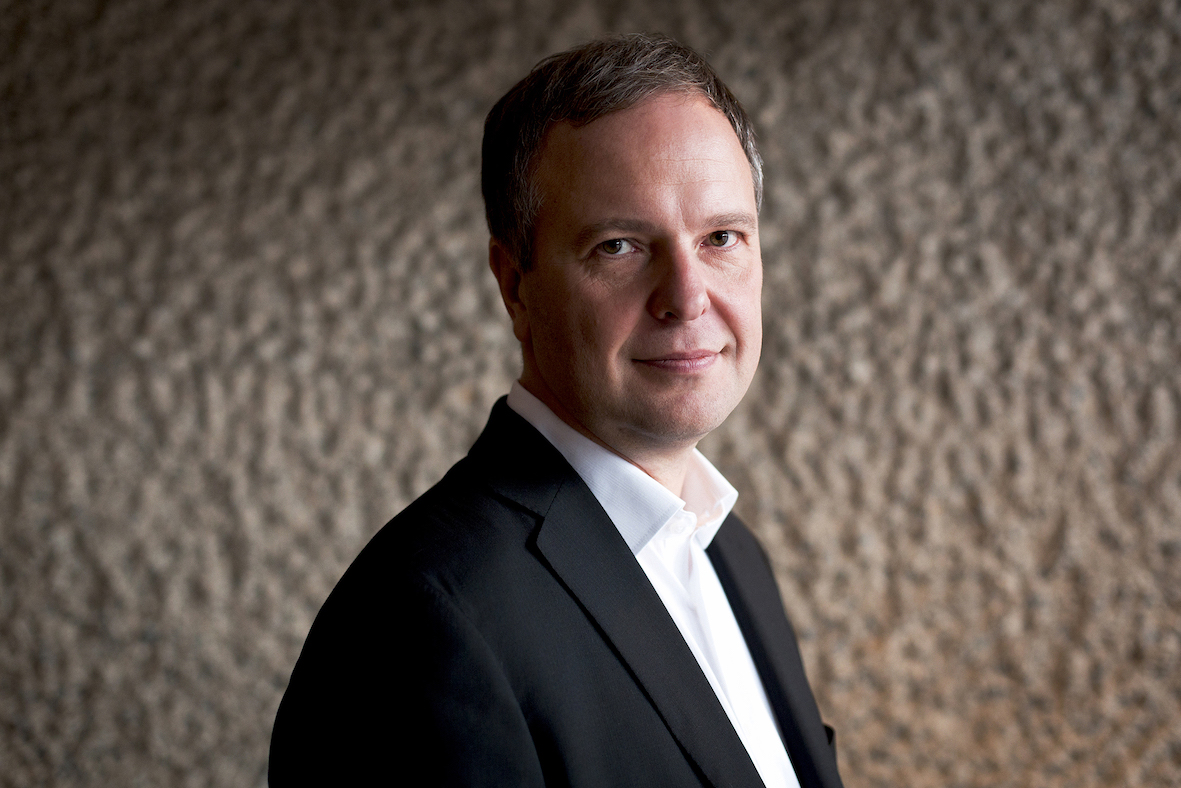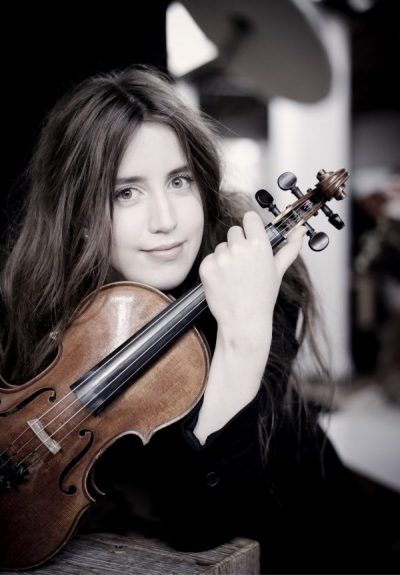Vilde Frang, Sakari Oramo / BBC Symphony Orchestra
Clyne / Britten / Beethoven
Tonhalle Maag, Zurich, 2018-03-24

2018-04-01 — Original posting
Vielfalt, anrührende Herzenswärme und neutraler Feinschliff: Frang, Oramo und das BBCSO — Zusammenfassung
Sakari Oramo und das BBCSO boten mit Vilde Frang als Solistin eine breite Palette an Werken. Das Konzert wurde eröffnet mit Anna Clynes Komposition “This Midnight Hour” von 2015. Vilde Frang bot eine intensive, berührende Interpretation von Benjamin Brittens Violinkonzert—der klare Höhepunkt des Abends. Leider klang Beethovens Pastorale nach der Pause eher konventionell, wenig inspiriert. Erst in der Zugabe von Jean Sibelius, dem Entr’acte aus der Suite “Pelléas et Mélisande” (Pelléas och Mélisande), lebte Sakari Oramo sichtlich wieder auf.
Table of Contents
Introduction
This concert was carried by the Foundation “Migros Kulturprozent”—a foundation that fulfills the constitutional obligation of the Migros retail chain to spend 1% of its annual budget on cultural ventures and institutions. For its March 2018 series of concerts through major concert locations in Switzerland, the foundation invited the BBC Symphony Orchestra under its Finnish chief conductor Sakari Markus Oramo OBE (*1965). The orchestra exists since 1930, its permanent residence is the Barbican Hall in London.
The program offered a broad mix of music, ranging from popular-classical (Beethoven’s Pastorale) to a highlight of twentieth century concerto literature (Britten’s violin concerto), up to contemporary music (the opening piece by Anna Clyne). I’m sure that there were people who were primarily interested in listening to “their” beloved Beethoven. These may have felt that they would have to “suffer through” the 20th and 21st century music in the first half of the concert. If ever they had an open ear and heart for music in general, I think they were thoroughly wrong with that opinion—quite to the contrary!
Indeed, on top of the all the interesting music, the concert offered the opportunity of another encounter with the Norvegian violinist Vilde Frang (*1986, see also Wikipedia), less than two weeks after her appearance in a fascinating chamber music evening in the same venue, on 2018-03-12. I was very much looking forward to that. And I was not disappointed in my high expectations!
Anna Clyne: This Midnight Hour
Anna Clyne (*1980, see also Wikipedia) is an English composer, now resident in the USA. After here formal music studies at the University of Edinburgh, she continued her studies at the Manhattan School of Music. She has since produced compositions ranging from orchestral to chamber music, to vocal works, as well as solo instrumental compositions, some of these also with tape / electronics.
The composition “This Midnight Hour” for orchestra is from 2015 and premiered in November that year in the Théâtre Espace Coluche in Plaisir (west of Paris). In this work, Clyne took her inspiration from two poems:
- the first one, “La música“ by the Andalusian poet Juan Ramón Jiménez Mantecón (1881 – 1959) describes a naked woman chasing though the night under clear skies, and
- the second poem is “Harmonie du soir“ by Charles Baudelaire (1821 – 1867).
What does Anna Clyne Make of the Underlying Poems?
Quite obviously, Anna Clyne plays with the stark contrasts between these two poems. Or rather: the contrasts between the scenarios / atmospheres described in these poems. For the most part, “This Midnight Hour” deals with “La música“, the more spectacular one of the two poems, with its dramatic, hectic action. She creates a kaleidoscope of rapidly switching scenarios: rhythmically complex and full of changes in tempo and meter.
“This Midnight Hour” starts with staccato sequences that remind me of music by Dmitri Shostakovich (1906 – 1975). The music is initially restless and strongly rhythmical, with growing complexity. A colorful soundscape describes a sequence of situations, then appears to fade away like a thunderstorm, returns again, gets flashy, shrill, pulsates machine-like. Then, all of a sudden, a peaceful, maybe moon-lit scene. The chasing restlessness returns. Then, there is a waltz-scene, in which the music turns harmonious, while melodically, the complexity remains. Flaring reminiscences of the initial scenes—peaceful serenity—a loud bang from the timpani—the end.
My description may make the music look / sound chaotic—but that should not scare anyone off. The music is largely tonal (occasionally polytonal), full of fantasy and imagination. It is very interesting, for sure, never unnecessarily noisy—and definitely worth listening to!
The Performance
In his stable posture, Sakari Oramo firmly controlled the rich instrumentation, the large orchestral setting. His right hand with the baton precisely gave the beat, defined the pace. Where needed, his left hand performed heavy Karate chops to indicate contrasting, opposite rhythms (especially in the violins).
Already in this first piece it was obvious that Oramo has formed the BBC Symphony Orchestra into an extremely reliable, experienced orchestral body. An instrument that masters the most complex polyrhythmic pattern and asynchronous polyphony without ever showing the slightest sign of insecurity. The orchestra is perfect in its sound balance and homogeneity, their control over dynamics is exceptional.
Rating: ★★★★
Britten: Violin Concerto in D minor, op.15
Benjamin Britten (1913 – 1976) wrote his Violin Concerto in D minor, op.15, in 1938/1939. This was shortly before he left the U.K. for the USA, because of WWII breaking out. The work has three movements, all of which flow into each other:
- Moderato con moto — Agitato — Tempo primo —
- Vivace — Animando — Largamente — Cadenza —
- Passacaglia: Andante lento — Un poco meno mosso
In the 1950, Britten produced a revised version of the concerto, with the help of violinist and teacher Manoug Parikian (1920 – 1987).
The orchestral accompaniment features 3 flutes (2 also piccolo), 2 oboes (1 also cor anglais), 2 clarinets, 2 bassoons, 4 horns, 3 trumpets, 3 trombones, tuba, timpani, percussion (glockenspiel, cymbals, triangle, bass drum, side drum, tenor drum), harp, and strings.
The Performance
After Anna Clyne’s excellent & interesting “overture”, the attention turned towards the soloist, Vilde Frang hence (to some degree) also away from the orchestra. Vilde Frang was setting a visual highlight in the center of the podium, in her strapless, bright, corn-yellow dress. However, nothing in her appearance was pretentious. Quite to the contrary: she seemed modest and inconspicuous in her behavior. Yet, with her playing she completely captured the audience from the first up to the last note! Vilde Frang was playing a 1864 violin by the French luthier Jean-Baptiste Vuillaume (1798 – 1875).
I. Moderato con moto — Agitato — Tempo primo —
The first movement opens with a Beethoven-inspired motif on the timpani, after which the orchestra briefly evolves into mf, then falls back into sotto voce. The bassoon introduces a short idée fixe of just five notes and keeps repeating it. Against this backdrop, Vilde Frang started playing her gentle, lyrical melody, very softly, with all subtlety, gradually intensifying, turning expressive also in the vibrato, while keeping the intonation clean. The following solo is more “sporty”. The soloist played this with expressive dynamics and articulation, her instrument projecting easily even at the highest pitch. The latter was of course helped by both Britten’s careful orchestral disposition, as well as by Oramo’s diligent control of the orchestra’s dynamics.
Vilde Frang was living in this music, appeared totally immersed; she kept listening into the music, yet remained in constant contact with orchestra and Sakari Oramo, even when she was playing with closed eyes. Her playing remained both lyrical and expressive, following Britten’s masterpiece down into the softest pp, ppp, and even flageolets: very touching, keeping the listener’s attention. At the same time, she never appeared to seek the listener’s attention. She was just purely serving the music she played.
Later into the movement, when the solo takes over the idée fixe, as expressive, spiccato & pizzicato, that was absolutely synchronous with the orchestra (seems trivial, but it really isn’t!). The intonation in this concerto is very challenging, as the pitch of the solo part is often so far apart from the accompaniment that it is hard for the soloist to keep in touch, pitch-wise. Then again, there are these sudden changes to percussive and virtuosic and/or very expressive playing: Vilde Frang was masterful at all this!
II. Vivace — Animando — Largamente — Cadenza —
Sakari Oramo and the orchestra presented the theme, but thereafter, the solo violin took and kept the lead. Vilde Frang did this effortlessly, and without ever pushing. She was absolutely firm in her very virtuosic solo with its poignant, percussive, multi-stop spiccato/staccato passages.
There was this amazing moment when the solo moved up into highest pitches, gradually fading away: the melody line seamlessly moved into piccolo and metallophones. This was done so subtly (and with perfect match in the pitch) that the actual transition was not even noticeable: amazing! Oramo‘s orchestral accompaniment was alert, super-attentive, throughout the virtuosic climax that precedes the cadenza. The latter is a very challenging mix of multi-stop staccato, spiced up with flageolets and left-hand pizzicato: a vivid monologue, enthralling, but also with lyrical moments, expressive, touching! Throughout this, Vilde Frang maintained her flawless intonation. The performance also demonstrated Britten‘s excellent orchestration, the careful disposition, which helped keeping the solo part audible at all times.
III. Passacaglia: Andante lento — Un poco meno mosso
The Passacaglia made me realize the marvelous cantilenas in this concerto: romantic music, composed with impressionist means. Such beautiful music from beginning to end. It’s music that I could listen to over and over again! And also here, I enjoyed the 100% agreement between solo, Sakari Oramo, and the orchestra—throughout the most virtuosic, rapid passagework.
The ending is so exhilarating with its intense brass and string colors! And then, this solo of breathtaking, ravishing beauty: purity, innocence, desire, longing for redemption, finally apotheosis, maybe? Such a warm-hearted mix of sadness and happiness, touching the innermost of one’s heart: I wasn’t very far from being touched to tears. It’s music that isn’t easily forgotten, which keeps sounding in one’s mind! Prior to the applause, the audience kept listening into the silence for a little eternity: this alone speaks for the intensity of the experience!
Rating: ★★★★★
Beethoven: Symphony No.6 in F major, op.68, “Pastorale“
Ludwig van Beethoven (1770 – 1827) composed and completed his Symphony No.6 in F major, op.68, “Pastorale“ (Pastoral Symphony) in 1808. The first performance happened in the same year, in Vienna.
- Erwachen heiterer Empfindungen bei der Ankunft auf dem Lande (Awakening of cheerful feelings on arrival in the countryside): Allegro ma non troppo
- Szene am Bach (Scene by the brook): Andante molto mosso
- Lustiges Zusammensein der Landleute (Merry gathering of country folk): Allegro
- Gewitter, Sturm (Thunder, Storm): Allegro
- Hirtengesang. Frohe und dankbare Gefühle nach dem Sturm (Shepherd’s song. Cheerful and thankful feelings after the storm): Allegretto
I’m not carrying owls to Athens by explaining, let alone analyzing this composition—it is all too well-known.
The Performance
There were indeed people who appeared only after the intermission. They did this presumably in the expectation to attend “their” Beethoven, i.e., their personal highlight. I don’t mean to criticize this attitude. However, there is no doubt in mind that these people missed the true highlights of the concert.
Sakari Oramo’s Beethoven could be called “modern, non-HIP”: flawless, perfect and careful in dynamics, coordination, tone and internal balance. It was unspectacular in the tempo selection and relations, warm-hearted, harmonious in transitions: a Beethoven devoid of rough edges, clean—classical purity?? It could well be that 50 years ago this would have been judged among the best possible performances. However, time has gone by, we can’t go back in history. I’m not even thinking of the truly historically informed performances that are becoming the new de facto standard: even “multi-purpose orchestras” such as the Tonhalle Orchestra Zurich can’t ignore the developments in the “HIP camp”.
Here, too much was missing from what has effectively become the “new normal”: the orchestra was way too big, the instruments all traditional. The only exception: the relatively hard (even though not wooden) drum stick heads. Then, there was the romantic/traditional orchestral setup (both violins on the left), too much legato, limited use of agogics, very little Klangrede, the sound too smooth, too polished. There was care for details, but still no life in articulation and dynamics.
I. Erwachen heiterer Empfindungen bei der Ankunft auf dem Lande: Allegro ma non troppo
Obviously relying upon routine and experience in the Orchestra, Sakari Oramo again conducted without baton. The orchestra carefully followed the notation. I noted that the first quaver in the violins in bars 470 and 474 (close to the end) was staccato rather than tied to the subsequent pair of semiquavers. Both legato and staccato options occur in the movement. Here, the old score asks for legato, and that’s also the way I hear this particular passage in my inner ear. However, I later checked, and it seems that the New Beethoven Edition has changed this, the performance was correct. The exposition was not repeated. This distorts the internal (formal) balance of the movement. However, it may be understandable, considering the length of the concert.
II. Szene am Bach: Andante molto mosso
The idyllic atmosphere in this movement was Beethoven’s intent. Here, however, it came from a rather big orchestral apparatus, which I think defeats the idea of a (classic) idyl. At least, the sound control was excellent. Everything sounded somewhat blurred, mellow. Still, the soundscape remained transparent, despite the big orchestra. The woodwinds were very good in their sound, though I did not have the feeling that Oramo gave them much freedom in shaping their solos.
In general, there were virtually no mishaps at all (I remember a single clarinet tone that failed to respond—a “little nothing”, really. Also sound from the French horns (modern valve horns, of course) was absolutely clean. As already in the Britten concerto, the sound / volume / balance control in the strings was excellent down to the finest pp. The other side of the coin, of course: the absence of harsh contrasts, any rough edges (poignant staccati, etc.) or other “al fresco” effects that typical HIP performances are offering.
III. Lustiges Zusammensein der Landleute: Allegro
A good tempo, though definitely not exuberant: Sakari Oramo certainly made sure all of the wind solos in this movement remained flawless, clean at all times. The second pass of the repetition felt a tad faster. But it never was in danger of getting out of control: taking risks, let alone appearing provocative is definitely not in Oramo’s scope. Consequently, there wasn’t much agogic play in this movement at all. The rhythmic coordination worked flawlessly, like a clockwork. I noted that for the fast movements (III & IV), Sakari Oramo was conducting with baton.
IV. Gewitter, Sturm: Allegro
Expectedly (from the above), the menace of the upcoming thunderstorm remained very much controlled. The only refreshing aspect here were the hard, sudden (almost scary) drumrolls / lightning strokes—theater, obviously. Too obviously—I could bot resist the impression of being kept at some distance from the action.
V. Hirtengesang. Frohe und dankbare Gefühle nach dem Sturm: Allegretto
With the last, serene movement, Oramo laid down the baton again, returning to “painting” the sound with hands and arms. He is not the man for experiments. An indication for this was also the romantic setup with both violins on the left. This certainly made perfect coordination between these two voices easier. However, exactly in this movement, these two voices are frequently alternating / responding to each other. This effect was entirely defeated in the listener’s ear. Yes, the pp in the coda was excellent. However, that to me did not save the performance.
Conclusion
Not unexpectedly, from watching the orchestra, there was very little (if any) sign of enthusiasm or active engagement among the musicians in the orchestra. And on the listener’s side: the finest, most perfect ppp does not compensate for a lack of the “inner fire”. Oramo may be in perfect control over every aspect of the orchestral apparatus: however, to me, this was also the downside of the performance: it was too controlled, too polished, too much routine. Here in Zurich, there have been so many historically informed Beethoven performances that such a traditional approach can no longer fascinate at all.
Rating: ★★★
Encore — Sibelius: Entr’acte from “Pelléas et Mélisande”, op.46
Sakari Oramo announced an encore—from his home country: from the Suite “Pelléas et Mélisande“ (Pelléas och Mélisande), op.46 by Jean Sibelius (1865 – 1957), the No.8, Entr’acte (actually the Prélude from Act IV, scene 1 of the incidental music), a short, light and jaunty piece of less than 3 minutes. Here, Sakari Oramo appeared to liven up, and the music appeared very carefully shaped and articulated, down to fine detail: quite obviously, this music is close(r) to Sakari Oramo’s heart!
Rating: ★★★★
The CD to the Concert
Korngold: Violin Concerto in D major, op.35
Britten: Violin Concerto in D minor, op.15
Vilde Frang, violin
James Gaffigan / Frankfurt Radio Symphony Orchestra
Warner Classics 0825646009213 (CD, stereo); ℗ / © 2016
Booklet: 12 pp. en/de/fr

Sure, a CD cannot be a perfect substitute for a live concert experience. On the other hand, a CD recording has its specific advantages. Not only can you focus on and hear every detail of the solo part, but you get to enjoy excellent sound balance, as probably on the best seats. You can re-listen again and again, and without the distractions from neighbors, from coughing in the audience, cell phones ringing (or even just the idea, the permanent danger of cell phones ringing). And of course there are no mishaps. Though, yes, there isn’t the visual aspect, nor the tension, the suspense inherent to a live performance…
Vilde Frang’s recording (see above) is with the Frankfurt Radio Symphony Orchestra (hr-Sinfonieorchester, founded 1929, see also Wikipedia) under the direction of James Gaffigan (*1979, see also Wikipedia).
On top of the Britten Concerto, the CD also includes the beautiful Violin Concerto in D major, op.35 from 1945 by Erich Wolfgang Korngold (1897 – 1957). It’s probably fair to say that the Korngold concerto isn’t quite at the level of Britten’s, in terms of compositorial mastership and richness in expression. However, it definitely is also very nice music. And it’s music that has been underestimated for decades.
Addendum
For the same concert, I have also written a (shorter) review in German for Bachtrack.com. This posting is not a translation of the Bachtrack review, the rights of which remain with Bachtrack.com. I created the German review using a subset of the notes taken during this concert. I wanted to enable my non-German speaking readers to read about my concert experience as well. Therefore, I have taken my original notes as a loose basis for this separate posting. I’m including additional material that is not present in the Bachtrack review.






